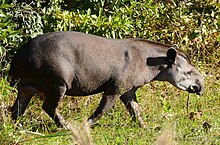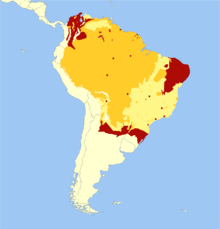Tapirus terrestris
| South American tapir | |
|---|---|
 |
|
| Mato Grosso, Brazil | |
| Scientific classification | |
| Kingdom: | Animalia |
| Phylum: | Chordata |
| Class: | Mammalia |
| Order: | Perissodactyla |
| Family: | Tapiridae |
| Genus: | Tapirus |
| Species: | T. terrestris |
| Binomial name | |
|
Tapirus terrestris (Linnaeus, 1758) |
|
 |
|
| South American tapir distribution Extinct Extant Probably extant |
|
Extinct Extant Probably extant
The South American tapir (Tapirus terrestris), Brazilian tapir (from the Tupi tapi'ira), lowland tapir or (in Portuguese) anta, is one of five species in the tapir family, along with the Mountain tapir, the Malayan tapir, the Baird's tapir, and the kabomani tapir. The lowland tapir is the largest surviving native terrestrial mammal in the Amazon.
It is dark brown, paler in the face, and has a low, erect crest running from the crown down the back of the neck. The round, dark ears have distinctive white edges. Newborn tapirs have a dark brown coat, with small white spots and stripes along the body. The South American tapir can attain a body length of 1.8 to 2.5 m (5.9 to 8.2 ft) with a 5 to 10 cm (2.0 to 3.9 in) short stubby tail and an average weight around 225 kg (496 lb). Adult weight has been reported ranging from 150 to 320 kilograms (330 to 710 lb).
The South American tapir can be found near water in the Amazon Rainforest and River Basin in South America, east of the Andes. Its range stretches from Venezuela, Colombia, and the Guianas in the north to Brazil, Argentina, and Paraguay in the south, to Bolivia, Peru, and Ecuador in the West.
...
Wikipedia

